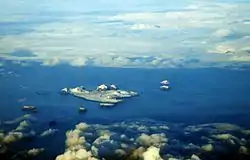Guðlaugur Friðþórsson
Guðlaugur Friðþórsson (born 24 September 1961) is an Icelandic fisherman who survived six hours in 5 °C (41 °F) cold water after his fishing vessel had capsized and furthermore trekked, for another three hours, across lava fields to reach a town for help in freezing conditions.

Sequence of events
On 11 March 1984, Guðlaugur and four other fishermen were fishing near the Westman Islands when their boat, which was engaging in fishing and carrying trenchers to another village, capsized at about 10 p.m.[1] It is suspected that the weight of the trenchers was miscalculated, causing the boat to be more susceptible to turbulent ocean conditions.[2][3]
During the sinking of their boat, off the coast of Heimaey in Vestmannaeyjar, Guðlaugur and two out of four other companions climbed on to the keel. After about 45 minutes, they swam towards the shore, yet the other two disappeared within 10 minutes. The only survivor of the crew of five, Guðlaugur swam for five to six hours in 5–6 °C (41–43 °F) water the 6 km (3.7 mi) to the island, wearing a shirt, sweater and jeans,[1] guided by a lighthouse.[4] He remained clear-headed throughout.[1]
Reaching the shore of Heimaey, Guðlaugur found himself at the most dangerous section of the island's coastline, due mainly to the waves hitting the coastal lava rock formations. After searching for and finding a suitable, flatter part of the shoreline, he finally got to land but had to walk with bare feet, traversing 3 km (1.9 mi) of volcanic scree.[4] When he knocked on a door at 7 a.m., nine hours after the boat had sunk, he was taken to the hospital. Guðlaugur's body temperature was below 34 °C (93 °F) yet he showed almost no symptoms of hypothermia or vasodilatation, only of dehydration.[2][3]
Testing
In autumn 1985, Jóhann Axelsson, head of Department of Physiology at the University of Iceland in Reykjavík, who had included Guðlaugur in an ongoing study about hypothermia, took Guðlaugur to London to see William Keatinge of the Physiology Department of the London Hospital Medical College and an expert in hypothermia. Together, they demonstrated that the 23-year old, 125 kg (276 lb) Icelander had phenomenal resistance to cold.[2][5][6]
See also
- The Deep – 2012 movie based on Guðlaugur's survival story
Footnotes
- Keatinge et al. 1986:171
- "Why the fat Icelander survived his Arctic swim". New Scientist. No. 1492. IPC Media. 23 January 1986. p. 26.
- "The True Viking Grit". The Viking Rune. March 2009. Retrieved 17 November 2016.
- Roberts, Sophy (27 February 2010). "Off the tourist trail in Iceland". Financial Times. The Nikkei. Retrieved 17 November 2016.
- Gehrmann, Alva (26 February 2014). "Naturphänomen: Das Geheimnis des Seehund-Mannes". Frankfurter Allgemeine Zeitung (in German). Fazit-Stiftung. Retrieved 17 November 2016.
- Keatinge et al. 1986:172